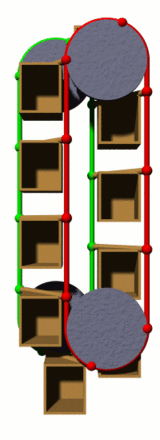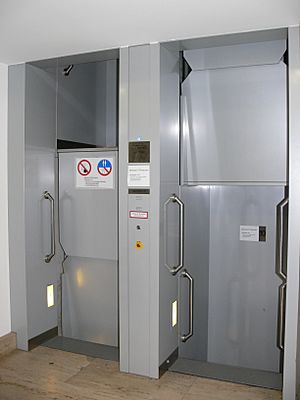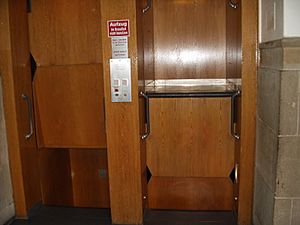Paternoster facts for kids
A Paternoster is a special kind of elevator. It's quite different from the elevators you usually see. Instead of one cabin that goes up and down, a Paternoster has many small cabins. These cabins move in a continuous loop, like a big chain. You can step on or off at any floor you want, without the elevator ever stopping!
The name "Paternoster" comes from a Latin phrase meaning "Our Father." It's thought to be named this way because the continuous loop of cabins looks a bit like the beads of a rosary moving along a chain.
Contents
How Paternosters Work
Paternosters work by having cabins attached to a strong chain. This chain moves slowly in a continuous loop. Some cabins go up on one side, and others go down on the other side. When a cabin reaches the top floor, it moves sideways and starts going down. When it reaches the bottom, it moves sideways again and starts going up.
Stepping On and Off
Using a Paternoster takes a little practice. You need to step into or out of a moving cabin. It's important to be quick and careful. Because the cabins never stop, you can always find one ready to take you to your floor.
Advantages and Disadvantages
Paternosters have some cool features, but also a few downsides.
Good Things About Paternosters
- Always Available: You never have to wait for a Paternoster. There's always a cabin coming along for you to hop into.
- Continuous Flow: Many people can use it quickly because it keeps moving.
Not-So-Good Things About Paternosters
- Slower Speed: Paternosters move slowly. If you need to go many floors, a modern, faster elevator might get you there quicker.
- Tricky to Use: It takes some getting used to. You have to step on and off while the cabin is moving.
- Safety Concerns: Because they keep moving, Paternosters can be difficult or unsafe for very young children, older people, or anyone who might have trouble moving quickly. Signs often warn about this.
- Not for Everyone: People using wheelchairs or crutches cannot use Paternosters easily.
History of Paternosters
The first Paternoster was built in England in 1884. It was designed by a man named J.E. Hall. These elevators became popular in the early 1900s, especially in large office buildings and government offices in Europe. They were a great way to move many people between floors quickly.
Where Are They Now?
Today, Paternosters are not built anymore. Modern elevators are safer and more accessible for everyone. However, you can still find many old Paternosters working in buildings, especially in countries like Germany, Austria, and the Czech Republic. They are often protected as historical machines.
Safety Tips for Paternosters
If you ever get a chance to ride a Paternoster, remember these tips:
- Be Quick and Careful: Step on and off smoothly and quickly.
- No Playing: Never play or mess around in a Paternoster.
- No Big Items: Don't try to carry large bags or items that could get stuck.
- Follow Signs: Always read and follow any safety signs near the Paternoster.
Images for kids














